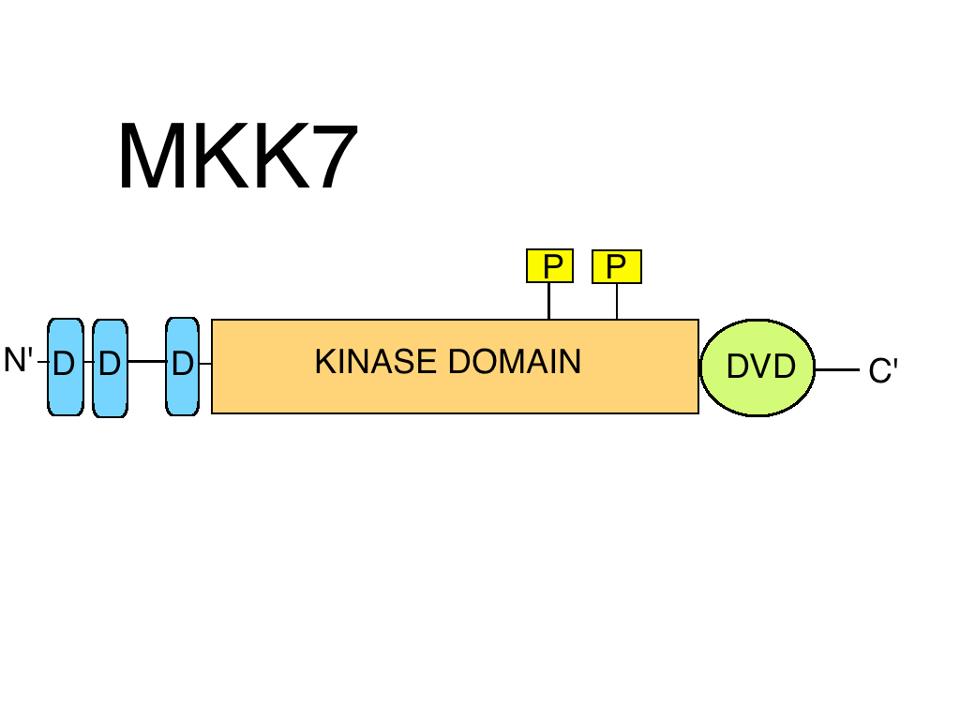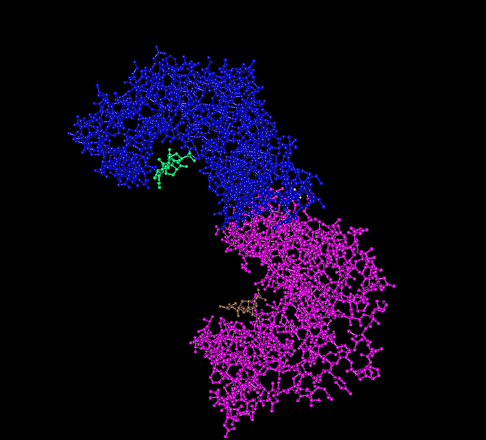|
MAP3K2
Mitogen-Activated Protein Kinase Kinase Kinase 2 also known as MEKK2 (MEK/ERK Kinase 2) is an enzyme that in humans is encoded by the ''MAP3K2'' gene. Function The protein encoded by this gene is a member of serine/threonine protein kinase family. This kinase preferentially activates other kinases involved in the MAP kinase signaling pathway. This kinase has been shown to directly phosphorylate and activate IkappaB kinases, and thus plays a role in NF-kappa B signaling pathway. This kinase has also been found to bind and activate protein kinase C -related kinase 2, which suggests its involvement in a regulated signaling process. Activation MEKK2 is activated through homodimerization and subsequent trans-autophosphorylation at MEKK2-S519. MEKK2 is regulated by 14-3-3 proteins which bind to MEKK2-phosphoT283. MEKK2 is regulated by SMYD3 which binds and methylates MEKK2-K260. Interactions MAP3K2 has been shown to interact with: * MAPK8, * MAP2K4, * MAP2K5, * MAP2K7 ... [...More Info...] [...Related Items...] OR: [Wikipedia] [Google] [Baidu] |
SMYD3
SET (Suppressor of variegation, Enhancer of Zeste, Trithorax) and MYND (myeloid-Nervy-DEAF-1) domain-containing protein 3 is a protein that in humans is encoded by the ''SMYD3'' gene. Function SMYD3 is a lysine methyltransferase which specifically methylates H3K4 and H4K5. SMYD3 plays a role in transcriptional regulation as a member of an RNA polymerase complex. It is also involved in cancer regulation. Expression SMYD3 is predominantly expressed in skeletal muscles and the testis. Model organisms Model organisms have been used in the study of SMYD3 function. A conditional knockout mouse line, called ''Smyd3tm2a(KOMP)Wtsi'' was generated as part of the International Knockout Mouse Consortium program — a high-throughput mutagenesis project to generate and distribute animal models of disease to interested scientists — at the Wellcome Trust Sanger Institute. Male and female animals underwent a standardized phenotypic screen to determine the effects of deletion. Twen ... [...More Info...] [...Related Items...] OR: [Wikipedia] [Google] [Baidu] |
MAP Kinase
A mitogen-activated protein kinase (MAPK or MAP kinase) is a type of protein kinase that is specific to the amino acids serine and threonine (i.e., a serine/threonine-specific protein kinase). MAPKs are involved in directing cellular responses to a diverse array of stimuli, such as mitogens, osmotic stress, heat shock and proinflammatory cytokines. They regulate cell functions including proliferation, gene expression, differentiation, mitosis, cell survival, and apoptosis. MAP kinases are found in eukaryotes only, but they are fairly diverse and encountered in all animals, fungi and plants, and even in an array of unicellular eukaryotes. MAPKs belong to the CMGC (CDK/MAPK/GSK3/CLK) kinase group. The closest relatives of MAPKs are the cyclin-dependent kinases (CDKs). Discovery The first mitogen-activated protein kinase to be discovered was ERK1 (MAPK3) in mammals. Since ERK1 and its close relative ERK2 (MAPK1) are both involved in growth factor signaling, the family ... [...More Info...] [...Related Items...] OR: [Wikipedia] [Google] [Baidu] |
MAP2K7
Dual specificity mitogen-activated protein kinase kinase 7, also known as MAP kinase kinase 7 or MKK7, is an enzyme that in humans is encoded by the ''MAP2K7'' gene. This protein is a member of the mitogen-activated protein kinase kinase family. The MKK7 protein exists as six different isoforms with three possible N-termini (α, β, and γ isoforms) and two possible C-termini (1 and 2 isoforms). MKK7 is involved in signal transduction mediating the cell responses to proinflammatory cytokines, and environmental stresses. This kinase specifically activates MAPK8/JNK1 and MAPK9/JNK2, and this kinase itself is phosphorylated and activated by MAP kinase kinase kinases including MAP3K1/MEKK1, MAP3K2/MEKK2, MAP3K3/MEKK5, and MAP4K2/GCK. MKK7 is ubiquitously expressed in all tissue. However, it displays a higher level of expression in skeletal muscle. Multiple alternatively spliced transcript variants encoding distinct isoforms have been found. Nomenclature MAP2K7 is also known as ... [...More Info...] [...Related Items...] OR: [Wikipedia] [Google] [Baidu] |
XIAP
X-linked inhibitor of apoptosis protein (XIAP), also known as inhibitor of apoptosis protein 3 (IAP3) and baculoviral IAP repeat-containing protein 4 (BIRC4), is a protein that stops apoptotic cell death. In humans, this protein (XIAP) is produced by a gene named ''XIAP'' gene located on the X chromosome. XIAP is a member of the inhibitor of apoptosis family of proteins (IAP). IAPs were initially identified in baculoviruses, but XIAP is one of the homologous proteins found in mammals. It is so called because it was first discovered by a 273 base pair site on the X chromosome. The protein is also called human IAP-like Protein (hILP), because it is not as well conserved as the human IAPS: hIAP-1 and hIAP-2. XIAP is the most potent human IAP protein currently identified. Discovery Neuronal apoptosis inhibitor protein ( NAIP) was the first homolog to baculoviral IAPs that was identified in humans. With the sequencing data of NIAP, the gene sequence for a RING zinc-finger doma ... [...More Info...] [...Related Items...] OR: [Wikipedia] [Google] [Baidu] |
SH2D2A
SH2 domain-containing protein 2A is a protein that in humans is encoded by the ''SH2D2A'' gene. Interactions SH2D2A has been shown to interact with MAP3K2 Mitogen-Activated Protein Kinase Kinase Kinase 2 also known as MEKK2 (MEK/ERK Kinase 2) is an enzyme that in humans is encoded by the ''MAP3K2'' gene. Function The protein encoded by this gene is a member of serine/threonine protein kinase fami .... References Further reading * * * * * * * * * * * {{Gene-1-stub ... [...More Info...] [...Related Items...] OR: [Wikipedia] [Google] [Baidu] |
MAP2K5
Dual specificity mitogen-activated protein kinase kinase 5 is an enzyme that in humans is encoded by the ''MAP2K5'' gene. Function The protein encoded by this gene is a dual specificity protein kinase that belongs to the MAP kinase kinase family. This kinase specifically interacts with and activates MAPK7/ERK5. This kinase itself can be phosphorylated and activated by MAP3K3/MEKK3, as well as by atypical protein kinase C isoforms (aPKCs). The signal cascade mediated by this kinase is involved in growth factor stimulated cell proliferation and muscle cell differentiation. Four alternatively spliced transcript variants of this gene encoding distinct isoforms have been described. Upstream This kinase itself can be phosphorylated and activated by MAP3K3/MEKK3, as well as by atypical protein kinase C isoforms (aPKCs). Downstream This kinase specifically interacts with and activates MAPK7/ERK5. Interactions MAP2K5 has been shown to interact with MAPK7, MAP3K2, Protein kinase M ... [...More Info...] [...Related Items...] OR: [Wikipedia] [Google] [Baidu] |
MAPK8
Mitogen-activated protein kinase 8 (also known as JNK1) is a ubiquitous enzyme that in humans is encoded by the ''MAPK8'' gene. Function The protein encoded by this gene is a member of the MAP kinase and JNK family. MAP kinases act as an integration point for multiple biochemical signals, and are involved in a wide variety of cellular processes such as proliferation, differentiation, transcription regulation and development. This kinase is activated by various cell stimuli, and targets specific transcription factors, and thus mediates immediate-early gene expression in response to cell stimuli. The activation of this kinase by tumor-necrosis factor alpha (TNF-alpha) is found to be required for TNF-alpha-induced apoptosis. This kinase is also involved in UV radiation-induced apoptosis, which is thought to be related to the cytochrome c-mediated cell death pathway. Studies of the mouse counterpart of this gene suggested that this kinase play a key role in T cell proliferation, ... [...More Info...] [...Related Items...] OR: [Wikipedia] [Google] [Baidu] |
MAP2K4
Dual-specificity mitogen-activated protein kinase kinase 4 is an enzyme that in humans is encoded by the ''MAP2K4'' gene. ''MAP2K4'' encodes a dual-specificity kinase that belongs to the Ser/Thr protein kinase family. MAP2K4 phosphorylates MAP kinases in response to various environmental stresses or mitogenic stimuli. MAPK8/JNK1, MAPK9/JNK2, and MAPK14/p38 are substrates for MAP2K4, but MAPK1/ERK2 and MAPK3/ERK1 are not phosphorylated by MAP2K4. Structurally, MAP2K4 contains a kinase domain that is phosphorylated and activated by MAP3K1(aka MEKK1). MAP2K4 contains multiple amino acid sites that are phosphorylated and ubiquitinated. Genetic studies using ''Map2k4'' knockout mice revealed embryonic lethality, impaired hepatogenesis and defective liver formation. Analysis of chimeric mice identified a role for ''Map2k4'' in T cell cytokine production and proliferation. ''Map2k4''-deficient chimeric mice frequently develop lymphadenopathy. MAP2K4 is altered in 1.97% of all hu ... [...More Info...] [...Related Items...] OR: [Wikipedia] [Google] [Baidu] |
Enzyme
Enzymes () are proteins that act as biological catalysts by accelerating chemical reactions. The molecules upon which enzymes may act are called substrates, and the enzyme converts the substrates into different molecules known as products. Almost all metabolic processes in the cell need enzyme catalysis in order to occur at rates fast enough to sustain life. Metabolic pathways depend upon enzymes to catalyze individual steps. The study of enzymes is called ''enzymology'' and the field of pseudoenzyme analysis recognizes that during evolution, some enzymes have lost the ability to carry out biological catalysis, which is often reflected in their amino acid sequences and unusual 'pseudocatalytic' properties. Enzymes are known to catalyze more than 5,000 biochemical reaction types. Other biocatalysts are catalytic RNA molecules, called ribozymes. Enzymes' specificity comes from their unique three-dimensional structures. Like all catalysts, enzymes increase the reaction ra ... [...More Info...] [...Related Items...] OR: [Wikipedia] [Google] [Baidu] |
14-3-3 Protein
14-3-3 proteins are a family of conserved regulatory molecules that are expressed in all eukaryotic cells. 14-3-3 proteins have the ability to bind a multitude of functionally diverse signaling proteins, including kinases, phosphatases, and transmembrane receptors. More than 200 signaling proteins have been reported as 14-3-3 ligands. Elevated amounts of 14-3-3 proteins in cerebrospinal fluid may be a sign of Creutzfeldt–Jakob disease. Properties Seven genes encode seven distinct 14-3-3 proteins in most mammals (See ''Human genes'' below) and 13-15 genes in many higher plants, though typically in fungi they are present only in pairs. Protists have at least one. Eukaryotes can tolerate the loss of a single 14-3-3 gene if multiple genes are expressed, but deletion of all 14-3-3s (as experimentally determined in yeast) results in death. 14-3-3 proteins are structurally similar to the Tetratrico Peptide Repeat (TPR) superfamily, which generally have 9 or 10 alpha helices, and ... [...More Info...] [...Related Items...] OR: [Wikipedia] [Google] [Baidu] |
Gene
In biology, the word gene (from , ; "...Wilhelm Johannsen coined the word gene to describe the Mendelian units of heredity..." meaning ''generation'' or ''birth'' or ''gender'') can have several different meanings. The Mendelian gene is a basic unit of heredity and the molecular gene is a sequence of nucleotides in DNA that is transcribed to produce a functional RNA. There are two types of molecular genes: protein-coding genes and noncoding genes. During gene expression, the DNA is first copied into RNA. The RNA can be directly functional or be the intermediate template for a protein that performs a function. The transmission of genes to an organism's offspring is the basis of the inheritance of phenotypic traits. These genes make up different DNA sequences called genotypes. Genotypes along with environmental and developmental factors determine what the phenotypes will be. Most biological traits are under the influence of polygenes (many different genes) as well as gen ... [...More Info...] [...Related Items...] OR: [Wikipedia] [Google] [Baidu] |




